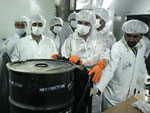 Reuters: After months of delays, Iran appears to be finalising a plant to convert a large amount of low-enriched uranium gas into an oxide form that would be less suitable for processing into nuclear bomb material, a U.N. watchdog report shows.
Reuters: After months of delays, Iran appears to be finalising a plant to convert a large amount of low-enriched uranium gas into an oxide form that would be less suitable for processing into nuclear bomb material, a U.N. watchdog report shows.
By Fredrik Dahl

VIENNA (Reuters) – After months of delays, Iran appears to be finalising a plant to convert a large amount of low-enriched uranium gas into an oxide form that would be less suitable for processing into nuclear bomb material, a U.N. watchdog report shows.
Under last year’s landmark accord with six world powers to curb Iran’s nuclear programme, it needs to take action by late July to limit its stockpile of uranium gas refined to a fissile concentration of up to 5 percent. It was one of the terms of the interim deal that won Tehran some sanctions easing.
To be able to do that, it has been building a facility near the central city of Isfahan for turning the gas into powder. A new U.N. nuclear agency report said its commissioning – final preparations originally expected last year – had now begun.
In addition, the International Atomic Energy Agency (IAEA) said Iran had transferred 4.3 tonnes of low-grade uranium gas to the site from its Natanz enrichment plant. It did not say when conversion into oxide would get under way.
“I think we will hear anytime soon that it has started up with the actual material,” one Western diplomat said.
The powers negotiated the six-month deal with Iran to buy time for talks on a final settlement that would remove the risk of a new Middle East war over Iran’s nuclear aspirations. Those talks began in February and are due to resume in June.
While Iran under the November accord halted its most proliferation-sensitive work, enrichment to a fissile concentration of 20 percent, it is allowed under the pact to continue producing uranium refined to up to 5 percent.
However, reflecting Western concern also about this reserve, Iran has undertaken to not increase it so that it is not larger by the end of the half-year accord than what it was when it took effect on Jan. 20, Western diplomats have said.
Earlier IAEA reports have shown that Iran is meeting all the other requirements under the interim agreement.
FAR APART
Iran says it is producing low-enriched uranium to fuel a planned network of nuclear power plants, not to develop bombs as the West fears. Uranium must be enriched to a high degree – about 90 percent fissile purity – for a nuclear weapon.
Experts say Iran potentially has enough uranium gas for a few nuclear weapons if refined much further. Limiting its overall enrichment capacity is expected be one of the thorniest issues in the negotiations on a long-term deal.
Because of the conversion facility’s delay, the low-grade uranium stockpile has grown to nearly 8.5 tonnes in May from 7.6 tonnes in February, according to the IAEA report seen by Reuters that was issued to member states late on Friday but has yet to be made public.
The longer it takes to launch the so-called Enriched UO2 Powder Plant (EUPP), the more Iran will have to process to meet the target by the deadline in less than two months’ time.
In view of the latest IAEA report, “no one believes they are going to have any problem doing it on time assuming it is starting in the next while”, the Western diplomat said.
The IAEA report said its inspectors had visited the EUPP on May 10 and “confirmed that commissioning of the facility using natural uranium had begun”. In an earlier report, in mid-April, it said construction of the plant was continuing.
Last year’s deal focused on securing a halt to 20 percent enrichment – as well as the removal of this stockpile – as this represents a relatively short technical step from bomb-grade uranium. It would take longer to reach that threshold from the 5 percent level.
But the powers – the United States, France, Germany, Britain, China and Russia – want Iran to also significantly scale back its capacity to produce low-enriched uranium to further lengthen the time required to produce enough material for a bomb. Iran says it needs to expand its enrichment capacity to make fuel for future atomic energy plants.
(Editing by Alison Williams)


